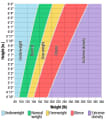How Can You Stay at a Healthy Weight?
If you want to get to and stay at a weight that's healthy for you, it's important to make healthy lifestyle changes. These steps can help.
Eat healthy foods
The kinds of foods you eat have a big impact on both your weight and your health. Reaching and staying at a weight that's healthy for you is not about going on a short-term diet. It's about making healthier food choices every day and changing how you eat for good.
Healthy eating means eating a variety of foods so that you get all the nutrients you need. Your body needs protein, carbohydrate, and fats for energy. They keep your heart beating, your brain active, and your muscles working.
Try to eat a variety of foods every day. These include:
- Whole grains, such as whole wheat breads and pastas.
- Fruits and vegetables.
- Dairy products, such as low-fat milk, yogurt, and cheese.
- Lean proteins, such as fish, poultry, lean meats, beans, and soy products like tofu.
All foods, if not eaten too often or in large portions, can be part of healthy eating.
Limit how often you eat foods that are high in fat, salt, sugar, or calories. Eat smaller servings, or look for healthy substitutes.
Be active
Part of reaching and staying at a weight that's healthy for you is being active.
When you're active, you burn calories. This makes it easier to reach and stay at a weight that's healthy for you. When you're active on a regular basis, your body burns more calories, even when you're at rest. Being active helps you lose fat and build lean muscle.
Try to get at least 2½ hours of moderate activity or 1¼ hours of vigorous activity each week. This may sound like a lot, but it's okay to be active in smaller blocks of time that add up to this. Any activity that makes your heart beat faster and keeps it there for a while counts. A brisk walk, run, or swim will get your heart beating faster. So will climbing stairs, shooting baskets, or cycling. Even some household chores like vacuuming and mowing the lawn will get your heart rate up.
Pick activities that you enjoy—ones that make your heart beat faster, your muscles stronger, and your muscles and joints more flexible. If you find more than one thing you like doing, do them all. You don't have to do the same thing every day.
Change your thinking
When you're trying to reach a weight that's healthy for you, it may help to change how you think about certain things.
Try not to compare yourself to others. Healthy bodies come in all shapes and sizes. And each person’s path to reaching their healthy weight is different. Have patience with yourself.
Pay attention to how hungry or full you feel. Sometimes people get out of practice when it comes to paying attention to their hunger and fullness signals. Learning to recognize those signals again can help you reach and stay at a weight that's healthy for you.
Focus on changes that improve your health instead of dieting. Try to change your habits a little at a time. Small changes are easier to stick with than big ones.
Learn more
- Healthy Eating
- Quick Tips: Cutting Calories
- Rethinking Drinking: Alcohol and Managing Your Weight



